Growing Chamomile for Tea
This post may contain affiliate links, which means that I may receive a commission if you make a purchase using these links. As an Amazon Associate I earn from qualifying purchases.
Growing chamomile for tea is easier than you think. Once the plants are established, it is drought tolerant and trouble free.
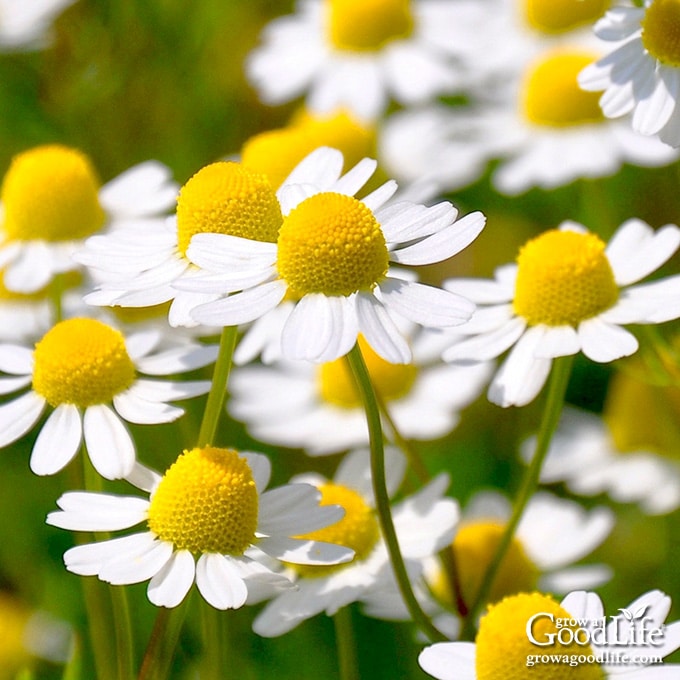
There is something so comforting to taking a break during the busy day and enjoying a cup of chamomile tea. I like to add a drop of local honey to sweeten it just a bit. Then I take a deep lingering breath over the cup as the tea steeps and cools down enough to drink.
Chamomile is a member of the daisy family (Asteraceae) and is best known for its soothing and calming properties and its fruity, apple-like flavor. Chamomile is documented through Egyptian, Roman, and Greek history as one of the most ancient medicinal herbs. Chamomile’s reputation as a remedy for relieving anxiety was confirmed in a 2009 study.
Today, chamomile is commonly used for many ailments including hay fever, menstrual disorders, inflammation, insomnia, muscle spasms, gastrointestinal disorders, and rheumatic pain. It can be applied to the skin for inflammations and skin diseases.
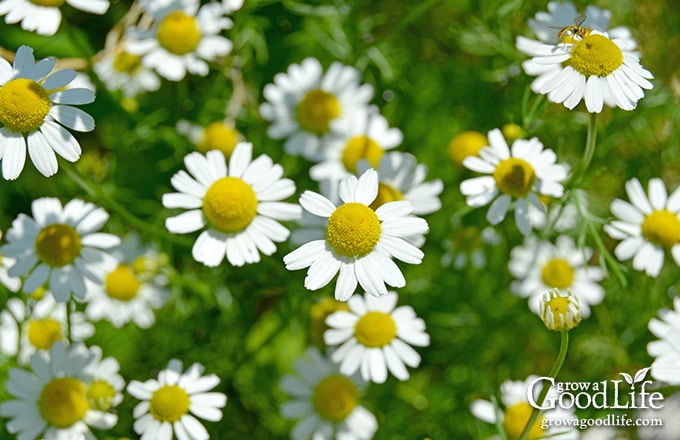
Two most popular types of chamomile are German Chamomile (Matricaria recutita), an annual that can grow up to 2-feet high; and Roman Chamomile (Chamaemelum nobile), a perennial that grows 12-inches high. Both contain essential oils and anti-oxidants that are calming and relaxing. Once I learned how easy it is to grow chamomile from seed, I have been growing chamomile for tea ever since.
Growing Chamomile from Seed to Tea
German chamomile grows best in a sunny location in the garden but can tolerate some shade. It can grow in containers but may become top heavy, so larger containers are recommended.
Once established, chamomile is pretty drought tolerant and trouble free. It isn’t a heavy feeder so will not need additional fertilizer through the growing season unless your soil is poor.
1. Sow Seeds Indoors Under Lights
Start chamomile from seed indoors about 6 weeks before your last expected frost date. Sow seeds by scattering a small pinch of the tiny seeds on the soil surface, mist with water, and tamp lightly. Learn more about starting seeds indoors.
Chamomile seeds need light to germinate, so do not cover the seed with soil before misting with a spray bottle to water.
2. Thin Chamomile Seedlings
Germination usually occurs within two weeks. Once the seedlings reach 4-inches high, select the strongest and healthiest plants and thin by snipping the others at the soil surface.
3. Transplant Chamomile Seedlings to the Garden
Harden off your chamomile seedlings and transplant to the garden after danger of frost is past along with other heat loving plants. Space the plants about 8-10 inches apart and water frequently until they are established and produce new growth. Usually within several weeks after transplanting, the first stems will begin reaching for the sky and the flowers begin to form and bloom.
4. Harvest Chamomile at Peak for the Best Flavor
Flower heads are ready to gather when the petals are flat or begin to fall back from the center. Gather the flowers on a sunny day after the morning dew has dried. Harvest blossoms by snipping them off when they are fully open.
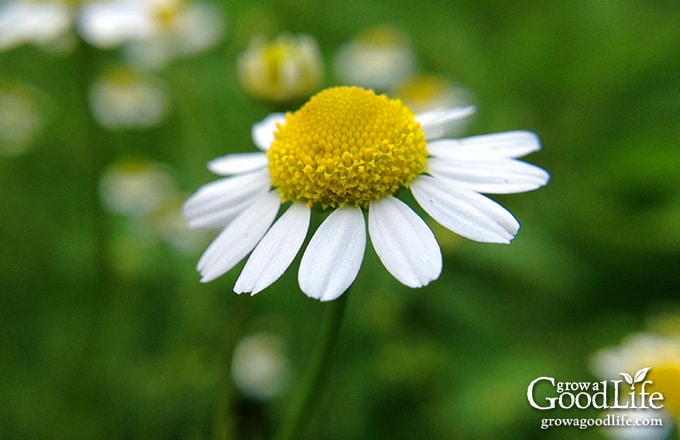
5. Dry the Chamomile Blossoms
Air-dry chamomile by layering the blossoms on a plate, and allow to dry naturally in an upper cabinet away from dust and sunlight. You can also spread the chamomile out on a window screen or drying screen to dry. Depending on the humidity, this usually takes 1-2 weeks.
- See how to make your own drying screen or check out these Stacking Herb Drying Racks.
Alternatively, you can use a food dehydrator to dry chamomile quickly. Lay the flower blossoms out on the drying screens and run at the lowest setting until dry.
You can tell when chamomile is dry, by crushing a blossom or two. It should crumble easily.
- See How to Harvest and Dry Herbs for Storage for more information on drying herbs.
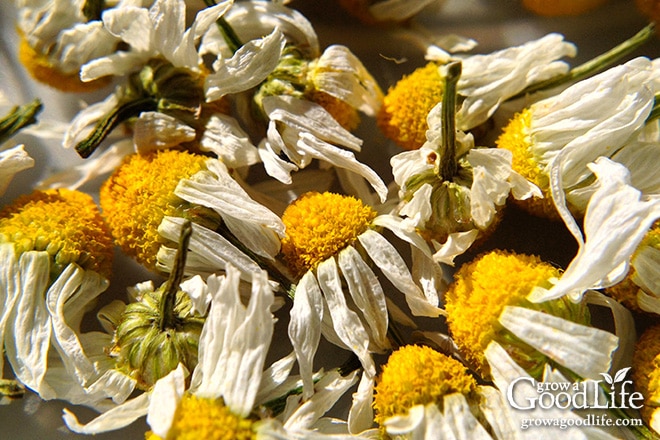
6. Store the Dry Chamomile Flowers for Tea
Once the chamomile is dry, store whole flower buds in a glass jar away from direct sunlight.
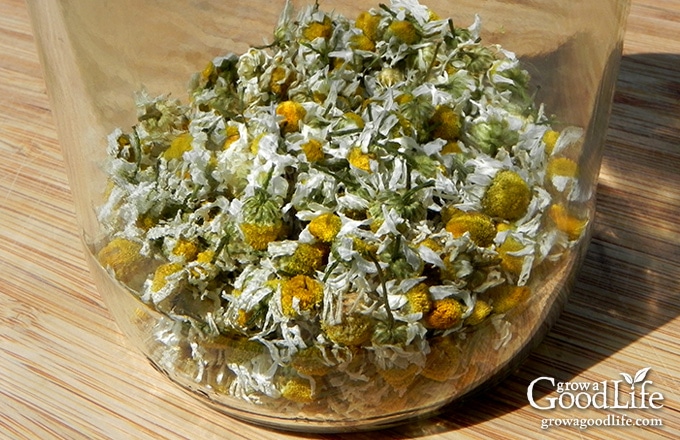
7. How to Make Chamomile Tea
To make tea, use about a teaspoon of dried chamomile flowers per cup. Place the chamomile blossoms in a tea infuser, pour boiling water over the chamomile flowers, and then steep for 5 minutes. When it is hot outside, I add ice cubes after steeping for a fresh flavored iced tea. Freshly harvested chamomile can be used for tea as well, but you will need twice as much. Drying concentrates the oil and flavor.
I enjoy a cup of chamomile mid-afternoon especially when things are busily humming along. It gives me a moment to sip, gather my thoughts, and plan my next move.
Growing your own culinary and medicinal herbs is very rewarding. Here are some additional articles on growing and preserving your own herbs:
- 7 Culinary Herbs to Start from Seed
- Grow Herbs Indoors: Herbs That Thrive Inside
- How to Grow, Harvest, and Preserve Bee Balm (Monarda)
- How to Harvest and Preserve Red Raspberry Leaf Tea
- How to Make Your Own Herbal Drying Screen via Herbal Academy
- How to Propagate a Rosemary Plant from Stem Cuttings
- How to Divide Chives
- How to Harvest and Dry Herbs for Storage
- 23 Ways to Use Chamomile via Herbal Academy
Sources and Further Reading:
- Klenner, Amanda. “How to use Chamomile to Reduce Stress.” Herbal Academy of New England.
- Foster, Steven. “How to Grow, Use and Identify the Chamomile Herb.” Mother Earth Living.
- Singh, Ompal, Khanam, Zakia. et al. “Chamomile (Matricaria chamomilla L.): An overview.” The National Center for Biotechnology Information.
- Amsterdam, Jay, Li, Yimei, Soeller, Irene, et al. “A Randomized, Double-Blind, Placebo-Controlled Trial of Oral Matricaria Recutita (Chamomile) Extract Therapy of Generalized Anxiety Disorder.” Journal of Clinical Psychopharmacology. Wolters Kluwer Health.
Disclosure: Any medical information is for informational purposes only. Always do your research and exercise caution when using any herbs or plants as medicine. Chamomile is not recommended for women who are breastfeeding or pregnant, and can cause allergic reactions in people with hay fever and some types of flower allergies.

I have just grown chamomile for the first time in a pot on my front porch.
I harvested about half the buds just now and started them drying but I’m noticing a shocking number of small black bugs now crawling out onto the paper towel. I imagine I shouldn’t rinse the buds so as not to ruin the flower and also to not encourage mold growth. But also I’m not sure what to do about the bugs. Any suggestions?
Hi Charity! Congratulations on your first chamomile harvest! It’s not uncommon to find small bugs in freshly harvested chamomile buds. To address this:
Shake Off the Bugs: Gently shake the buds to dislodge any remaining bugs.
Air Dry: Place the buds in a single layer on a mesh screen or a paper towel in a well-ventilated area. This allows any bugs to crawl away.
As you mentioned, rinsing can cause mold. You can lightly mist the buds with water to dislodge the bugs before harvesting, but make sure they dry thoroughly before harvesting.
I have picked chamomile to dry for tea but it is not drying out. It is particularly humid here in New England right now. So I tossed all except for what I picked this past week. I just purchased a dehydrator. Is it too late to put in what I picked?
Meg, I am in New England too and agree it so humid here right now. If the newer batch is still good, I would go ahead and layer it on the dehydrator screens to complete the drying process. If not, just wait for a new flush of blossoms and start with those.
I’m growing german chamomile for tea for the first time. The tea comes out so bitter that I have to spit it out. Do you know why? I was really looking forward to the home-grown soothing tea I was used to from the store bought chamomile…
Rita, Chamomile is a rather bitter plant. However, there are several ways to make your tea less bitter: 1) Harvest blossoms just as the flower opens. Older blooms can turn bitter. 2) Dehydrate with no or low heat. 3) Use hot water around 90˚F to make the tea. 5) Steep for only 5 minutes. Longer steeping increases the flavor. 6) German chamomile tastes more bitter than Roman chamomile. 7) Finally, you may have plants that just tastes sharper than others. You can cut the bitterness of your tea by adding a little honey.
Sorry to be exacting, but how many FRESH German chamomile flower heads would you use for an 8 fl.oz cup? thanks, Ben
Ban, It depends on how strong you like your tea. You will need twice the amount of fresh chamomile than dried, so I would start with 2 teaspoons of fresh blossoms and see how you like it.
I bought some seeds years ago and every year they volunteer all over my garden in between my neat rows of vegetables. They always make me smile.
Louise, I love this. I also have lots of chamomile volunteers around the garden. 🙂
@kaya, I prefer perrenials too so I planted Roman chamomile. I wish I had known that Roman chamomile makes a bitter tea. German chamomile is what we buy in the stores…
Have you tried the Roman Chamomile for teas? I prefer perennials when I have the option, but if the flavor/quality of the German Chamomile is markedly better then I would want to go with that! Love the photos! Such pretty little plants.
I started my chamomile indoors over a month ago. It germinated fine but has not grown any larger since a few days after germination. Do I need to thin it to only one little plant? What could I be doing wrong? I am starting it in seed pods in a tray.
Meagan, It’s hard to know what is going on with your chamomile seedlings. I suspect the “seed pods” don’t have any nutrients to feed your chamomile plants. Chamomile isn’t a heavy feeder, but it does need some nutrients to grow. You could try watering with liquid fish emulsion to give your plants a boost.
If it is too early to plant your seedlings outside, you could pot up the plants to larger containers and use a soil mix with fertilizer or add some organic fertilizer. This article may be helpful: https://growagoodlife.com/starting-seedlings-indoors/
Thank you so much, I’ll try to move it to a different pot and see how it goes.
This is my 1st time growing chamomile and i plant it with NFT hydroponic system, outdoor. I live in Indonesia(tropics country), 43days, 8-10cm, but i notice they are growing to down side to earth not up to sky, looks like a carrot leaf. It’s normal?
Thanks,
Sumitro Lie
Sumitro, Yes, it is normal for the foliage to look thin and feathery. The chamomile flower stalks will grow in the middle of the foliage and the flower will open up towards the sky.